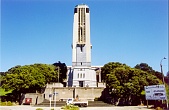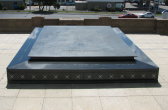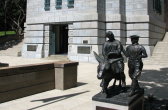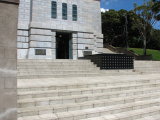
Travel to any town in New Zealand and one thing you are virtually guaranteed to meet is the town war memorial. For a small country we participated heavily in both World Wars, Boer War and several others besides. For that we paid a heavy price in lives lost, every town has its list of people killed and Wellington is no different. One of Wellington's memorials, and the National War Memorial, is the Carillon with the Hall of Memories tucked in at the ground floor.
Situated in the centre of town, and just outside the Central Business District, it enjoys a commanding position - perched atop a hillock in the centre of the main valley. With no tall buildings near it it makes a very recognisable landmark in the city. (And is, incidentally, an easy way to navigate towards the Basin Reserve park for people not familiar with Wellington. The park is just a little ways down the road from the memorial.) In a lot of ways the Carillon is one of those feature that identifies Wellington as home for me. My primary school, being next to the Basin Reserve, had a good view of the tower and I have driven past it so many times that I have a hard time imagining the city without it's presence.
It's very familiarity has counted against it though as I have passed it so many times without really looking at it. And it isn't till you get close to it that you notice the wonderful texture of the rock and the workmanship present. The cream rock is Mt Somers Limestone and the grey is Nelson Marble, which in the polished areas of the entranceway looks especially nice. This outer sheath of rock was originally a Putaruru Ignimbrite but this rock doesn't weather well, eroding quickly, and has had to be replaced with the current sheath. I must admit I don't remember this building in anything but it's current look so presumably this re-sheathing took place over twenty years ago. [2]
Proceeding inside you get to see more Nelson Marble, speckled Coromandel Tonalite and pink Hanmer "Marble" - which isn't really a marble at all, it just looks like one and is in fact a limestone. Apparently the Hanmer "Marble" takes a polish quite well and thus gets used a lot as an interior decorative rock in buildings around New Zealand. All these rocks have been used in various polished sections, on the interior, allowing you to study the interior structure of the rock quite easily. Not to mention looking very pretty.
Due to the thickness of the rock the building takes quite a while to warm up and in the late afternoon it still is a cool and quiet place. The rock makes good sound insulation as well, muting the normal drone of traffic and other city sounds into a distant melange, easily ignored. All of which is totally fitting for it's function as a memorial for the quiet contemplation of the war dead. I have to admit for this sort of thing I am a sucker for elegant simplicity, something this building has in spades. It is ornate, without being baroque or even mildly complicated.
Of course this simplicity focuses attention on the ornate parts that are present. Between the pillars alcoves contain the plaques and standards of various fighting regiments and forces that New Zealand has raised. Standards also hang from the pillars as well, several of which can be seen in the above photograph. At the end of the hall lies a statute and a lecturn, both of which are used as part of the Anzac day ceremonies held annually in this hall. Finally, providing a muted dash of colour in the hall, there are the stain glass windows lining the ceiling.
As I said before it is strange for me to even contemplate Wellington being present without this building being there. Even stranger is that when it came time to find out about the building only two books in the Wellington Central public library mention the building. One talks about the monument as an aside, a part of it's chronicle of building materials used in New Zealand. The other dates from 1936 and is more interested in the Carillon as an instrument than anything else. (Which does mention the interesting point that there is a sister to this Carillon in Ottawa, I wonder if that Carillon is used as a war memorial as well?) In the intervening sixty two years it seems no one else has written a history of the place or considered it worth mentioning otherwise. Mayhap I haven't been looking in the right places, I hope so, because it would be quite sad otherwise for such a remarkable piece of work to go unappreciated and unremarked for so long.
One fascinating part of trying to dig up information about the Carillon was finding these two photographs [1]. The first is of the dedication and opening ceremony on the 25th of April 1932. Contrast it with the second taken in 1936, where the then Dominion Museum (next National Museum and now not a Museum at all, it's function having been supplanted by the Museum of New Zealand.) is suddenly present in the background. Given the solidity of the Museum building I am surprised that it was constructed in under four years. It reinforces again, almost as much as seeing the very bare hills around the Carillon in the first photograph, just how quickly the city changes and how much it has changed.
For me the monument is as much a part of the flavour of Wellington and as recognisable a landmark as the parliment buildings. It is also a special place providing a small way to connect with the stories my parents tell me of the experiences my grandparents went through. It is open most daylight hours for casual visitors and usually has easy parking near it. Why not drop by and have a look at this distinctive building for yourself sometime?
Update 13th November 2006
 As often happens when getting the car serviced I end up wandering town
while I wait for the mechanics to finish their work. Seeing as the
garage is a scant two and a bit blocks away from where the Carillon is
located I made that one of my destinations while waiting. A few things
have changed since last I stopped. For starters the Dominion Museum
building behind it now hosts a chunk of Massey University's campus so
has plenty of students strolling past. Secondly was the addition,
officially opened 11th of November 2004, of the Tomb of the Unknown
Warrior. One unknown New Zealand serviceman was returned from France to
be buried here at the National Memorial to represented all the
servicemen and woman who have died in the various conflicts New Zealand
has been involved in.
As often happens when getting the car serviced I end up wandering town
while I wait for the mechanics to finish their work. Seeing as the
garage is a scant two and a bit blocks away from where the Carillon is
located I made that one of my destinations while waiting. A few things
have changed since last I stopped. For starters the Dominion Museum
building behind it now hosts a chunk of Massey University's campus so
has plenty of students strolling past. Secondly was the addition,
officially opened 11th of November 2004, of the Tomb of the Unknown
Warrior. One unknown New Zealand serviceman was returned from France to
be buried here at the National Memorial to represented all the
servicemen and woman who have died in the various conflicts New Zealand
has been involved in.
 It is a perfectly servicable memorial tomb but I must admit to being a
little underwhelmed with it. There was considerable fanfare about this
tomb being put in place and it doesn't really suit the location it has
been placed in. The dark black tones of it don't suit the lighter greys
and browns of the Carillon or the white of the Hall of Memories. I was
more impressed with the statue dedicated to all the medics which was put
in place on the 75th anniversary of the Gallopoli landings in 1990.
This, based on a photograph of stretcher bearer Richard Alexander
Henderson and his donkey, is a poignant reminder of the cost of war and
the nobler deeds people can perform during such times. Very well
scultped it captures your eye and naturally draws attention to it
despite being a fraction of the size of the memorial tomb.
It is a perfectly servicable memorial tomb but I must admit to being a
little underwhelmed with it. There was considerable fanfare about this
tomb being put in place and it doesn't really suit the location it has
been placed in. The dark black tones of it don't suit the lighter greys
and browns of the Carillon or the white of the Hall of Memories. I was
more impressed with the statue dedicated to all the medics which was put
in place on the 75th anniversary of the Gallopoli landings in 1990.
This, based on a photograph of stretcher bearer Richard Alexander
Henderson and his donkey, is a poignant reminder of the cost of war and
the nobler deeds people can perform during such times. Very well
scultped it captures your eye and naturally draws attention to it
despite being a fraction of the size of the memorial tomb.



I also grabbed a few more exterior shots of the Carillon itself. I
hadn't appreciated how intricate the stone flowers carved into the main
doorframe are. You can also see the front facing of the tomb which is
covered with white crosses.
Finally while I was visiting I was lucky enough to hear the bells being played as part of what I think was a test or practice session. I recorded a short snippet which you download as an MP3 file. You can also hear the background traffic noises, birdlife in the trees surrounding the Carillon and the various students going about their business as well.
Ignimbrite - volcanic ash formed by
deposition & partial welding of a high temperature, high velocity flow of
fragmented magma.
Marble - recrystalised limestone
metamorphosed at high temperatures and pressure.
Tonalite - grey, often speckled, coarsely
crystaline plutonic rock with more than 65% silica; mostly of
plagioclase, quartz and hornblende.
Pluton - an intrusive body of molten magma
that cools to form plutonic rock.
Plagioclase Feldspar - calcium-sodium
aluminosilicate mineral characteristic of basalt and andesite.
"National War Memorial" by E.E. Muir, 1936.
"Granite and Marble : A Guide to Building Stones in New Zealand" by Bruce W. Hayward, 1987.
[1] The two photographs are sourced from E.E. Muir's book, but unfortunately no credit was present listing the actual photographers who took them. A certain amount of digital tidying has been performed on them too - mostly to counteract a certain amount of damage the book has suffered from and also to remove various markings the library has placed on the book against theft.
[2] With my recent revisited I found a plaque indicating that the Carillon was reopened and rededicated in a ceremony performed on the 26th of February 1986. Which is late enough that I should really remember seeing the work being done. And I do have vague recollections of seeing scaffolding surrounding the tower while at school. I just never connected it or noticed the change of the outer sheath of rock. It should have been especially noteable given that Queen Elizabeth the Second and the Duke of Edinburgh were present at it.